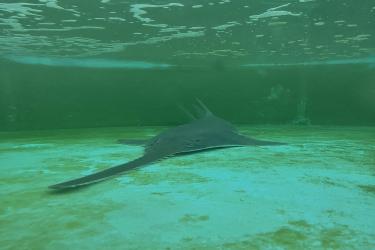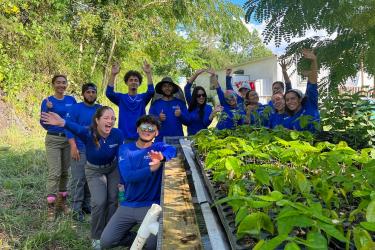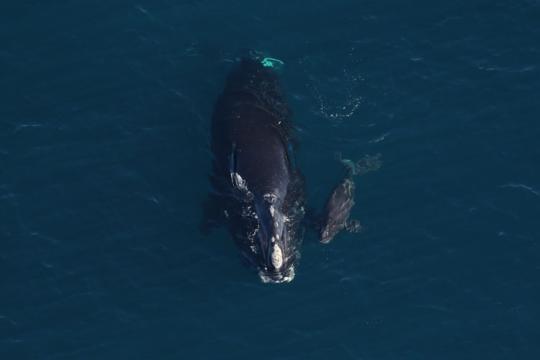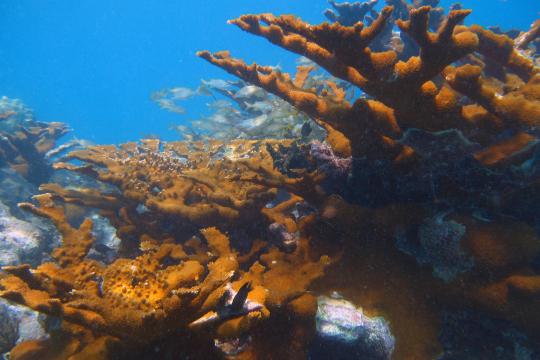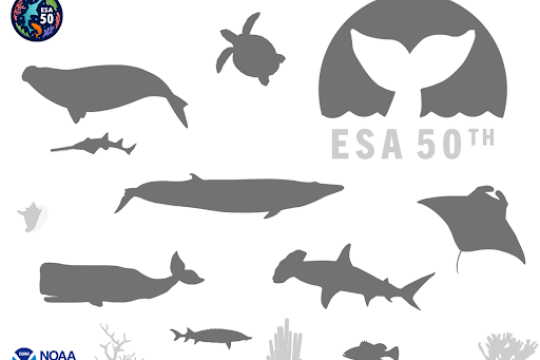What is NOAA Fisheries announcing today?
- NOAA Fisheries is announcing a final rule to list queen conch as threatened under the Endangered Species Act.
- All public comments that were submitted in response to the proposed rule were considered and addressed in the final rule.
How did NOAA Fisheries assess the queen conch population in order to reach a determination of threatened?
- NOAA Fisheries assembled a status review team of seven experts and conducted a comprehensive review of available information to develop a status review report; this report then underwent independent peer review, and peer reviewer comments are publicly available at: https://www.noaa.gov/sites/default/files/2022-09/ID425-Peer- Review-Report-Queen-conch.pdf.
- Several analyses developed to support the status review are now published in the scientific literature, and the status review has been published as a NOAA Technical Memorandum: https://www.fisheries.noaa.gov/resource/document/endangered-species- act-status-review-report-queen-conch. These publications all required additional levels of internal and external review.
- A model was developed to map how pelagic (i.e., free-floating) queen conch larvae from different jurisdictions were connected to each other by ocean circulation throughout the wider Caribbean. This “connectivity model” was developed to improve our understanding on how overutilization and the depensatory processes (due to low adult conch densities) affect queen conch population connectivity throughout the Caribbean region.
- The results demonstrate that overutilization has resulted in the loss of critical up- current populations. Historically important ecological corridors for larvae flow have collapsed, reducing connectivity among populations.
What types of threats does the queen conch face?
- The primary threat to the queen conch is overutilization through commercial, recreational, and subsistence fishing, and illegal, unreported, or unregulated fishing.
- The existing regulatory mechanisms are inadequate to control overutilization. There are significant issues with regulatory compliance, efficacy of minimum size regulations to prevent juvenile harvest, limited enforcement of regulations, sparse and inconsistent population monitoring, and substantial poaching.
- The available information indicates climate change, specifically sea surface temperatures, ocean acidification, and potential changes in circulation patterns, will likely affect the reproduction, growth, and survival of queen conch in the foreseeable future (i.e.,, by 2100).
- Density thresholds for successful reproduction and other aspects of the queen conch’s life history make it particularly vulnerable to threats.
Why is adult queen conch density so important?
- Queen conch are slow moving marine snails that require direct contact to mate. Adult conch density therefore influences mate finding, reproduction, and recruitment. Thus, population density and age structure were important to consider in assessing the species status.
- Our review found that the majority of the countries (64%) have conch populations that are below the minimum adult density threshold required to support mate finding. These populations are not reproductive and unlikely to be contributing to recruitment and population growth.
How many queen conch are estimated to remain in the wild?
- Total abundance is estimated to be between 743 million - 1.4 billion individuals; however, total abundance estimates are uncertain due to limited survey coverage in many areas and the coarse resolution of regional habitat maps.
Will the final rule to list queen conch under the ESA create new prohibitions on imports/exports of queen conch products?
- The final rule does not create any additional, or more specific, prohibitions on queen conch trade or harvest. However, the section 4(d) ESA authorizes NOAA Fisheries to issue protective regulations for the conservation of threatened species. We intend to develop protective regulations under section 4(d) of the ESA at a later time; those proposed regulations will be published in the Federal Register with opportunity for public comment.
- Puerto Rico and the U.S. Virgin Islands have queen conch fisheries in territorial waters. There is also a queen conch fishery in federal waters off St. Croix within the US. Virgin Islands.
- Harvesting queen conch is currently prohibited in waters off the coast of Florida.
What is a threatened species and how is it different from an endangered species?
- The Endangered Species Act defines an endangered species as “any species which is in danger of extinction throughout all or a significant portion of its range,” and a threatened species as one “which is likely to become an endangered species within the foreseeable future throughout all or a significant portion of its range.” We interpret an “endangered species” to be one that is presently at risk of extinction. A “threatened species” is interpreted as a species that is not currently at risk of extinction but is likely to become so in the foreseeable future.
- An endangered species also automatically receives protections under section 9 of the ESA upon listing. The prohibitions of section 9 of the ESA do not automatically apply to species listed as threatened; however, we may extend any of these prohibitions to threatened species through a regulation issued under section 4(d) of the ESA (16 U.S.C. 1533(d)).
Can aquaculture help restore queen conch populations?
- Aquaculture, also known as aqua farming, is the rearing of animals from egg to adult for food and stock enhancement. Through aquaculture, queen conch can be fished without removing individuals from the wild. Farmed queen conch could potentially be used in the future to restock wild populations.
- The Puerto Rico Queen Conch Hatchery is located at the Naguabo Fishing Association on the Húcares Beach, Malecon de Naguabo. This project is a partnership between the Queen Conch Lab, Florida Atlantic University Harbor Branch Oceanographic Institute; Conservación ConCiencia; and the Naguabo Fishing Association.
What are the next steps in the listing process for queen conch?
- We will review the best scientific data available to make a determination regarding critical habitat for the species; any critical habitat would be proposed in a separate rulemaking with opportunities for public comment.
- We will hold public and virtual meetings with regional stakeholders and federal, state, and academic experts to inform the best course of action to ensure the recovery of the species.
- We will work to develop and propose protective regulations under section 4(d) of the ESA to promote the conservation of the species. A 4(d) rule can include some or all of the prohibitions provided for endangered species and can also include customized protections and exceptions.
- This final listing rule includes a solicitation for public input on critical habitat and protective regulations. Please see the final rule for information on how to provide input on these next steps. Both critical habitat designation and issuing protective regulations would be subject to proposed and final rulemaking with opportunities for public comment on NOAA Fisheries’ proposals.
Whom do I contact for more information?
- Orian Tzadik by phone at 813-906-0353 or Orian.Tzadik@noaa.gov.
